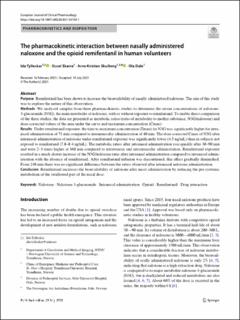| dc.contributor.author | Tylleskär, Ida | |
| dc.contributor.author | Skarra, Sissel | |
| dc.contributor.author | Skulberg, Arne Kristian | |
| dc.contributor.author | Dale, Ola | |
| dc.date.accessioned | 2021-09-29T06:51:10Z | |
| dc.date.available | 2021-09-29T06:51:10Z | |
| dc.date.created | 2021-08-13T16:55:22Z | |
| dc.date.issued | 2021 | |
| dc.identifier.citation | European Journal of Clinical Pharmacology. 2021, 1-8. | en_US |
| dc.identifier.issn | 0031-6970 | |
| dc.identifier.uri | https://hdl.handle.net/11250/2785857 | |
| dc.description.abstract | Purpose Remifentanil has been shown to increase the bioavailability of nasally administered naloxone. The aim of this study was to explore the nature of this observation. Methods We analysed samples from three pharmacokinetic studies to determine the serum concentrations of naloxone3-glucuronide (N3G), the main metabolite of naloxone, with or without exposure to remifentanil. To enable direct comparison of the three studies, the data are presented as metabolic ratios (ratio of metabolite to mother substance, N3G/naloxone) and dose-corrected values of the area under the curve and maximum concentration (Cmax). Results. Under remifentanil exposure, the time to maximum concentration (Tmax) for N3G was signifcantly higher for intranasal administration of 71 min compared to intramuscular administration of 40 min. The dose-corrected Cmax of N3G after intranasal administration of naloxone under remifentanil exposure was signifcantly lower (4.5 ng/mL) than in subjects not exposed to remifentanil (7.8–8.4 ng/mL). The metabolic ratios after intranasal administration rose quickly after 30–90 min and were 2–3 times higher at 360 min compared to intravenous and intramuscular administration. Remifentanil exposure resulted in a much slower increase of the N3G/naloxone ratio after intranasal administration compared to intranasal administration with the absence of remifentanil. After remifentanil infusion was discontinued, this efect gradually diminished. From 240 min there was no signifcant diference between the ratios observed after intranasal naloxone administration. Conclusion. Remifentanil increases the bioavailability of naloxone after nasal administration by reducing the pre-systemic metabolism of the swallowed part of the nasal dose. | en_US |
| dc.language.iso | eng | en_US |
| dc.publisher | Springer | en_US |
| dc.rights | Navngivelse 4.0 Internasjonal | * |
| dc.rights.uri | http://creativecommons.org/licenses/by/4.0/deed.no | * |
| dc.title | The pharmacokinetic interaction between nasally administered naloxone and the opioid remifentanil in human volunteers | en_US |
| dc.type | Journal article | en_US |
| dc.type | Peer reviewed | en_US |
| dc.description.version | publishedVersion | en_US |
| dc.source.pagenumber | 1-8 | en_US |
| dc.source.journal | European Journal of Clinical Pharmacology | en_US |
| dc.identifier.doi | 10.1007/s00228-021-03190-1 | |
| dc.identifier.cristin | 1925937 | |
| cristin.ispublished | true | |
| cristin.fulltext | original | |
| cristin.qualitycode | 2 | |

